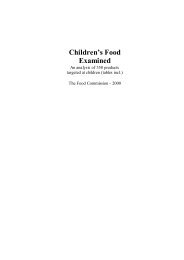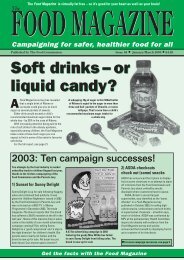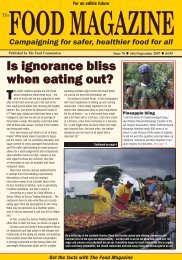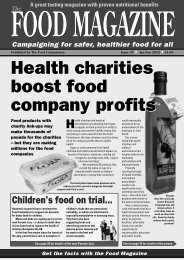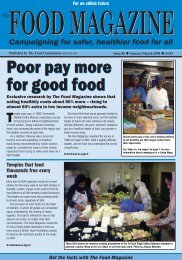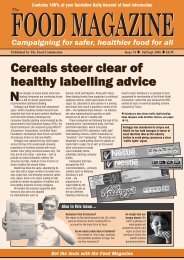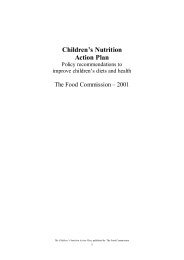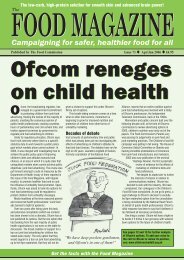Food Magazine - The Food Commission
Food Magazine - The Food Commission
Food Magazine - The Food Commission
You also want an ePaper? Increase the reach of your titles
YUMPU automatically turns print PDFs into web optimized ePapers that Google loves.
farming<br />
Milk – with extra<br />
oestrogen<br />
Two-thirds of our milk<br />
supply comes from<br />
pregnant cows, but we<br />
don’t know what that<br />
means for our health.<br />
Tim Lobstein continues<br />
investigating the impact<br />
of modern farming on<br />
the quality of the food<br />
we buy.<br />
<strong>The</strong> UK population guzzles milk in nearly<br />
the same quantities as our cars guzzle<br />
petrol. On average, every household buys<br />
about five litres of milk every week. And that is<br />
just the domestic scene: more milk is drunk at<br />
school, at the fast food restaurant, in canteens<br />
and offices, while travelling and even in the<br />
hospitality zone of the <strong>Food</strong> <strong>Commission</strong>’s local<br />
bank.<br />
And if you add in the cheese, yogurt, crème<br />
fraiche and occasional Ben & Jerry’s ice cream,<br />
the total comes to the equivalent of 4.4 litres a<br />
week for every member of the population, about<br />
a pint a day. (Since you ask, the UK’s petrol<br />
consumption for cars is about 6 litres a week per<br />
person).<br />
<strong>The</strong> figures also show that the UK imports the<br />
equivalent of 3 billion litres of milk each year,<br />
and exports 2.5 billion litres – quite crazy, but<br />
that’s another story.<br />
<strong>The</strong>re are many aspects of milk that have<br />
concerned consumers and nutritionists over the<br />
years, of which the most worrying for health is<br />
probably the fatty acid profile, especially the high<br />
levels of myristic acid – a saturated fatty acid<br />
which is particularly potent at stimulating a rise<br />
in LDL blood cholesterol, the form which is a<br />
major risk factor in cardiovascular disease.<br />
While attempts have been made to lower the<br />
fat content of milk, and while most consumers<br />
have been making significant changes to their<br />
diets by replacing full-fat milk with reduced-fat<br />
versions, other concerns remain. Among these is<br />
the problem of hormones.<br />
Nearly two decades ago, the government<br />
started allowing trials of bovine somatotropin<br />
(BST), a synthetic growth hormone produced<br />
using genetic engineering and designed to<br />
increase the efficiency with which cattle turned<br />
their feed into milk. <strong>The</strong> hormone worked only too<br />
well, with udders full to bursting, putting immense<br />
stress on the cow with consequent increases in<br />
the incidence of mastitis (infection of the udder)<br />
and other ailments such as lameness. <strong>The</strong><br />
treatment significantly raised the levels of a<br />
hormone, insulin-like growth factor-1 (IGF1), in<br />
the milk, to levels which contributed to the<br />
European Union’s decision to ban the use of BST<br />
for commercial milk production.<br />
<strong>The</strong> point of this story is that it opened up a<br />
new area of concern for consumers, namely the<br />
hormone content of milk supplies. And yet,<br />
surprisingly, very little research has been<br />
published on the topic. And, even more to the<br />
point, there is even less information about how<br />
changes in modern farming practices may<br />
influence the quantities and types of hormones<br />
found in milk.<br />
How milk hormones affect health<br />
What we do know<br />
<strong>The</strong> average lifespan of modern dairy cows is<br />
only about five years. In normal circumstances<br />
they can live to an age of 25-30 years, but<br />
physiological stress and a farmer’s sharp eye for<br />
a cow whose yield is declining, means that the<br />
animals are turned into meat and bone meal in<br />
just a few years – equivalent to a teenager in<br />
human terms.<br />
Modern dairy farmers hope their cows will<br />
to produce over 6,000 litres of milk during their<br />
annual 10 month lactation, with some prize<br />
cows producing 12,000 litres, equivalent to<br />
more than 40 litres (70 pints) a day during peak<br />
production. <strong>The</strong> graph (opposite) shows the<br />
average for the UK, which has risen from 16<br />
pints per day to 39 pints per day in just a few<br />
cattle-generations.<br />
A dairy cow raised by industrial farming<br />
methods is expected to give birth to a calf at<br />
least every 12 months, to keep her producing<br />
milk. A pregnancy is nine months, so cows are<br />
simultaneously lactating and pregnant for a<br />
Milk may contain varying amounts of many hormonal substances, with an unknown effect on our<br />
own endocrine systems. When pregnant, a cow’s hormone levels may rise, but 70% of our milk<br />
comes from pregnant cows. This may rise to 80% or even 90% using new farming methods.<br />
Yet the research evidence, which is very sparse, points to several possible influences on our<br />
normal endocrine functions and on childhood growth and development. <strong>The</strong>se are summarised in<br />
the box, but it cannot be stressed too highly that the research base is extremely poor, and we<br />
should be seeking better evidence.<br />
Milk may contain…<br />
Progesterone<br />
Oestrogen<br />
Cortisone<br />
and other adrenal steroids<br />
IGF-1 growth hormone<br />
Leptin<br />
Oxytocin<br />
Prolactin<br />
Thyroxine<br />
and triiodothyronine<br />
Source: PubMed searches (http://www.ncbi.nlm.nih.gov/)<br />
Which may be linked to…<br />
Prostate cancer<br />
Colon cancer<br />
Endometrial cancer<br />
Breast cancer<br />
Diabetes<br />
Obesity<br />
Cardiovascular disease<br />
Allergies<br />
Acne<br />
and pubertal development



